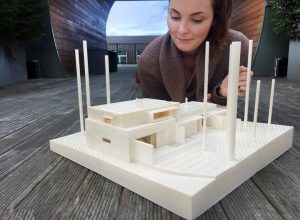A few decades ago 3D printers sounded like science fiction, but now they are an increasingly widespread reality, having a wide variety of applications.
What types of printers are there?
3D printing does not come from a single technology, but we can differentiate several classes of printers based on their printing style:
- By stereolithography (SLA). It is the origin of 3D printing. It consists of the application of a beam of ultraviolet light on a photosensitive liquid resin, which allows it to solidify, forming the desired object.
- Selective Laser Sintering (SLS). It has similarities with the previous one, but here a laser is projected on powdered materials melting the material to solidify it.
- By Injection. It is the method most similar to printing on paper, in this case, instead of ink, layers of liquid photopolymer are injected, which is subsequently cured.
- Deposition of molten material (FDM). It is the most widely used type, a technology that consists of depositing the molten polymer layer by layer on a base. The material melts and is expelled to later solidify again.
Do all printers have the same printing capacity?
Each 3D printing technology is not only different in terms of performance. But it is also different in its efficiency, cost, and quality it achieves.
If you want to print multiple copies of an object, injection printers are the best solution, since once you have the mold they can produce at high speed and at low cost. In case you need a greater variety of objects, the ideal is to opt for the more adaptable FDM. While, if you are looking for the best quality, SLS and SLA are the best options.
Materials that accept
As for the materials with which they work, there are also big differences. Injection technology is ideal for metal parts, while SLA uses resin. If you want a wider range, laser printing and FDM are suitable.
What times does 3D printing handle?
The speed of 3D printing varies according to the material, the complexity of the object (contours, fill level, etc.), and the technology used.
To give several examples, a tennis ball would take around 2 hours to print. A chess figure 40 minutes, and a mobile case 20.
Sectors that have put it into operation successfully
3D printing technologies are a great help in the manufacture of materials and are successfully applied in many areas, among which are:
- Aerospace: takes advantage of the ability to obtain strong and light parts.
- Medical: thanks to the wide variety of biocompatible materials that can be printed.
- Transportation: in the manufacture of automobiles, materials that are light, resistant. And withstand high temperatures are essential, something that is achieved with 3D printing.
- Energy: this technology allows us to obtain insulating materials that withstand extreme conditions, something very valuable in the energy sector.
3D printing has come to transform industrial manufacturing and its application is increasingly widespread. It is a still young and developing technology, so its potential is very great.


